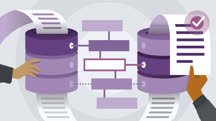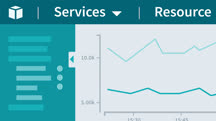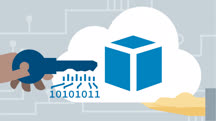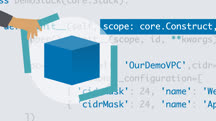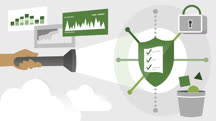Course catalog
Categories
Showing 981-1,000 of 9,134 items.
AWS for Developers: RDS MySQL Database with Lambdas
Learn how to leverage RDS (relational databases) for MySQL Database with Lambdas.
AWS for Developers: S3
Learn how to securely store and retrieve data with Amazon Simple Storage Service (S3), one of the most popular and reliable service offerings in Amazon Web Services (AWS).
AWS for Developers: Simple Email Service (SES)
Learn how to use AWS Simple Email Service (SES), the cloud-based email delivery service, for a cost-effective and simple way to reliably send emails to your users.
AWS for Developers: SNS, SQS, and SWF (229259)
Are you unclear about how to best work with the messaging, queueing, and workflow services offered by AWS? If so, this course can help. Join Jeremy Villeneuve as he shines a spotlight on three key AWS services—Simple Workflow Service (SWF), Simple Queue Service (SQS), and Simple Notification Service (SNS)—and how they can help you effectively handle complex workflows. Since each service was designed to address a specific methodology of the messaging/queueing/workflow model, Jeremy spells out the key differences in methodologies so you can ensure you're using the right tool for the right job. Along the way, get hands-on experience with SQS and SNS, and learn how to refactor an existing application that tracks user state within a database table to a workflow model provided by SWF.
AWS for Developers: Step Functions
Learn how to use AWS Step Functions to quickly design and run serverless workflows that allow you to coordinate multiple AWS services.
AWS for DevOps: Continuous Delivery and Process Automation
Learn how to establish continuous delivery and automate processes with Amazon Web Services (AWS). Review topics in the first domain of the AWS Certified DevOps Engineer exam.
AWS for DevOps: High Availability and Elasticity
Learn tools, best practices, and design patterns for effective application scaling (elasticity) and high availability for applications running on the AWS cloud.
AWS for DevOps: Monitoring, Metrics, and Logging
Learn about instrumenting production AWS applications. Explore topics from the Monitoring Metrics and Logging domain of the AWS Certified DevOps Engineer – Professional exam.
AWS for DevOps: Performance Optimization Best Practices
Get tips and tricks for optimizing performance as an AWS DevOps engineer. Learn how to measure performance and optimize network traffic, compute (EC2), and storage services.
AWS for DevOps: Security, Governance, and Validation
Learn best practices for security, governance, and validation. Explore topics in the third domain of the AWS Certified DevOps Engineer exam: Security, Governance, and Validation.
AWS Infrastructure as Code for Software Developers
Leverage your existing programming skills to deploy infrastructure. Explore a real-world architecture, and see how to write the code to deploy it using AWS CDK and Python.
AWS Machine Learning by Example
Take a deeper dive into machine learning with Amazon Web Services (AWS). Learn how to approach common machine learning tasks using key techniques.
AWS Quick Tips for Developers
Get bite-sized tips for working more efficiently with some of the most essential services in Amazon Web Services (AWS), the popular cloud platform.
AWS Security Best Practices for Developers
Create stronger, more secure applications for AWS deployment. Learn security best practices for Identity and Access Management, S3 storage, Key Management Service (KMS), and Cognito.
AWS Security Hub First Look (228001)
AWS Security Hub—a security dashboard and insights tool from Amazon—provides users with a one-stop dashboard from which they can monitor their deployment for common security issues, including vulnerable services and publicly available S3 buckets. Security Hub provides a convenient and flexible search tool to filter issue types, and identifies fixes that need to be applied to resources. Amazon is currently allowing users to take this powerful tool out for a spin as a preview. In this course, Scott Simpson provides a first look at Security Hub, helping to acquaint you with the tool before it officially joins the AWS suite. Learn about the main features of Security Hub, as well as how it can help you gain new insights and resolve security problems.
AWS Well-Architected Framework: Cost Optimization Pillar (230619)
The AWS Well-Architected Framework helps architects build secure, high-performing, resilient, and efficient infrastructures for their applications through five pillars. This course takes an in-depth look at the cost optimization pillar. Instructor Mark Wilkins reviews how to use cost optimization with the design properties of the cost optimization pillar, then goes into key financial management concepts. He explores budgeting and forecasting tools for cloud costs. He shows you how to monitor cost, usage, and the decommissioning of resources, then offers information on how to choose a pricing model. Mark goes over how to manage costs using the Billing and Cost Management dashboard. He also discusses the challenge of changing your design as new features and abilities are provided over time, then shows you how to match supply and demand. Plus, he provides a demo in which he uses the Well-Architected Tool to answer cost optimization pillar questions.
AWS Well-Architected Framework: Operational Excellence Pillar
Take a deeper look at the first pillar of the AWS Well-Architected Framework: operational excellence.
AWS Well-Architected Framework: Performance Efficiency Pillar (228375)
The AWS Well-Architected Framework includes strategies to help enterprise architects compare workloads against AWS-identified best practices. It is designed to help architects build secure, high-performing, resilient, and efficient infrastructure for their applications and comprises five pillars: operational excellence, security, reliability, performance efficiency, and cost optimization. In this course, Mark Wilkins takes an in-depth look at the fifth pillar, performance efficiency. Mark covers the different computing resources—including compute, storage, database, and network—and shows how to optimize performance for each. He also illustrates the importance of fine-tuning performance to maintain efficiency over time. This course is designed to work in conjunction with the remaining courses in the path, and while Mark covers some topics that were detailed in the other pillars, in this course he looks at these topics specifically from the viewpoint of efficiency.
AWS Well-Architected Framework: Reliability Pillar (228494)
The AWS Well-Architected Framework was designed to help architects build secure, high-performing, resilient, and efficient infrastructure for their applications. The framework is comprised of five pillars: operational excellence, security, reliability, performance efficiency, and cost optimization. In this course, designed as part of a six-part series covering the AWS Well-Architected Framework, take a deeper look at the third pillar: reliability. Discover the purpose and place of the reliability pillar, plus key AWS reliability services such as CloudWatch. Learn about designing reliable infrastructure with Availability Zones, load balancing (ELB), and DNS (Route 53). Along the way, review demonstrations of real-world challenges and see how to implement key services to prevent—and recover from—failures.
AWS Well-Architected Framework: Security Pillar
Take a deeper look at the second pillar of the AWS Well-Architected Framework: security.



